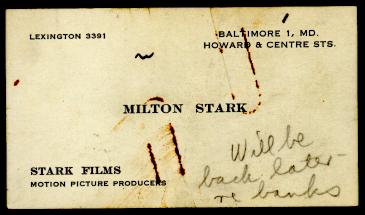By Donald Kirkley
If you meet a man who occasionally
falls into a trancelike state and begins telling you how he has just
swapped two Tammanies and a rabbit-in-cabbage for a squirrel-and-stump
with only the tail missing, donít be alarmed.
And if he says he is on the lookout for a buffalo chasing boy up
tree, unpainted, and will trade a miniature bucking ram or black lacquered
elephant for same, you can be sure he is harmless.
He is merely suffering from the rare fever that strikes collectors of
antique toy banks.
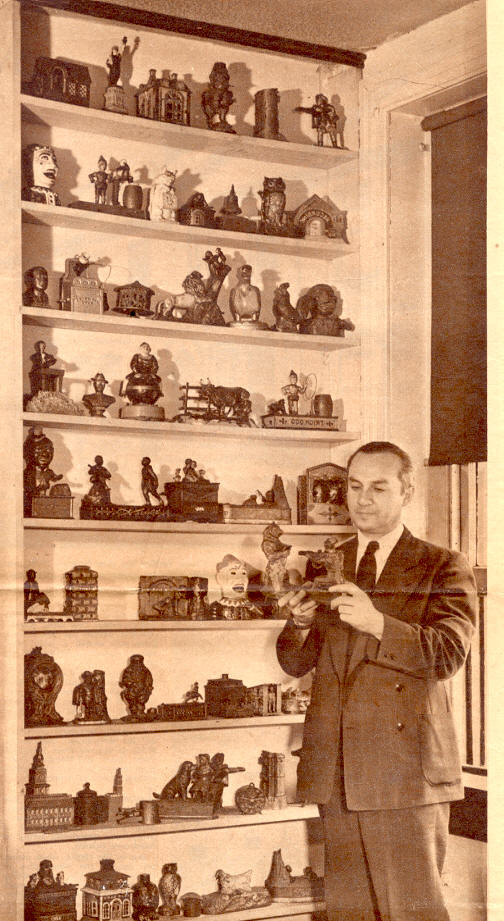
Although Milton Stark started collecting toy banks only two years
ago,
he now has more than 400 of them. The Indian on the mechanical bank
he holds in his hand shoots a penny into the stomach of the bear.
A cast iron dog jumps through a hoop on another.
Milton Stark is a case in point. Two years ago this Baltimorean was
down in Virginia making a motion picture for some local group and minding
his own business, when the toy bank bug put the whammy on him. In the
lobby of his hotel was a native son with a little stand full of tourist
bait, such as Confederate money and minie balls from the field of Antietam.
Among the wrack of war were some cast-iron coin traps, such as most
of us over forty used in cadging small change from visiting uncles, when
we were kids.
Mr. Stark remembered that a friend of his, Aaron Straus, is fond of
relics, and decided to buy him one of these. The smooth-talking Virginian
wound up selling him six, for a total of $110. When he came back to
Baltimore, he showed his treasures to the nearest expert, who said, "It's
a gyp, son; they're worth about half that much."
THIS made the photographer angry. "Two can play at that game," he
said, and set out to recoup by shrewd trading, fortified this time by some
knowledge of the subject.
Today he is the owner of 400-odd banks, representing an investment of
several thousand dollars in cash and an inestimable number of hours spent
in the pursuit of his hobby.
They have overflowed his home at 3707 West Strathmore Avenue, and are
bursting out of an upstairs room at his office.
Somewhat mournfully, he warns prospective collectors that the
gadgets, small in themselves, take up plenty of space, need lots of
dusting, and may require the taking of a strong stand with the wife.
Aside from the satisfaction derived from the banks themselves, Mr.
Stark has found great pleasure in exploring the interesting, specialized
little world inhabited by other collectors.
Much lore has been accumulated, and is transmitted through various
hobbyist magazines, letter writing, antique dealers, and personal
contacts. One book, far from complete, has been written on banks, and new
facts are always coming to light.
MR. STARK discovered a banker in Fostoria, Ohio, who used note paper
with a butting goat letterhead; a dealer in Syracuse, N.Y., who stamped on
his postal communications during the war the legend "Unconditional
Surrender Absolutely," with the U, S and A in capitals; a lady in Wyaconda,
Mo., who sent him a nice bank in return for some hard-to-get films and
told him the story of her life, and another lady in Terre Haute, Ind., who
has built up a neat little business out of repairing and repainting banks.
In the course of his own business travels, he has struck up acquaintances
with half a dozen collectors in half a dozen cities from New York to
Chicago.
The story of toy banks goes back, of course, to ancient times, but
along about the 1860's cast iron still and mechanical coin traps got to be
a sort of craze in this country. An extraordinary amount of ingenuity went
into the invention of new models, and they sold like hot cakes, by the
hundreds of thousands.
Nobody knows how many different models there are, and nobody can give
even a rough estimate. Each year, up to now, hundreds of new still banks
are put out by manufacturers - the dime stores are always flooded with
them - but about 25 years ago the toy makers stopped making the mechanical
ones. Only a few new ones have appeared in the stores in recent years, and
they were not of good quality.
PERHAPS a hundred models are fairly plentiful, well known by name,
and available. But there are many variations, some entailing a
considerable difference in value. It makes a difference, too, whether all
parts are perfect and whether the original has been repaired or repainted.
You have to watch your step, the more so because there is no set
standard of value. The same bank may bring $2 in one city, $25 in another.
Collectors fix their own prices, subject to much haggling, and more often
than not augment their collections by swapping like the horse traders of
an earlier generation.
Ten dollars is a fair price for one of the more clever models, in
good condition. Rare specimens have changed hands for as much as $125. Mr.
Stark paid $75 for one in which two boys play leapfrog when a penny is put
in the slot and a lever pulled; he thinks this was a bargain. He paid $35
for a bucking ram, which turned out to be a modern forgery, worth a
fraction of the price.
It is easy to copy some models, and collectors must know how to
detect fakes. One still bank, a replica of the Flatiron Building, has been
counterfeited in bulk. Since a genuine F.B. fetches around $7, the unknown
counterfeiters must have cleaned up.
SOME people acquire stills, others only "mecks"; Mr. Stark is partial
to both. The stills are made of clay, tin, assorted alloys, wood, and
other materials. The simplest are in the shapes of animals, public figures
(T.R., F.D.R., Sousa, Pershing), hats, mail boxes, trunks, books, jugs,
soldiers, tanks, and so forth in endless variety. He has Happy Hooligans,
Buster Browns, Billikens, baseball players, a clumsy likeness of the
battleship Maine.
More pretentious are roughhewn replicas of public buildings such as
Independence Hall, and various structures in Washington, D.C. There is a
large category of modern gadgets, given away for advertising purposes -
refrigerators, radios and so forth.
There are innumerable banks of the miniature safe type, opened with
keys or combinations. There is a line of cash register banks, and counting
banks, some dating back to 1870. These add up the coins as they are
inserted.
Even the simplest mechanical banks are fascinating to operate. Our
own childhood was enriched by the possession of a device in which a
kneeling Indian, equipped with a gun, shot a penny into the middle of a
large and ferocious bear. It was very pleasant to see this vanished friend
and financier again, on one of Mr. Stark's shelves, and to slay the
monster once more with a coin.
This projectile affair is one of two chief types of mechanical bank.
The other is the performing group, in which various stunts are performed
by the cast iron actors, worked with levers which must be oiled with a
penny or nickel.
Other projectile banks owned by Mr. Stark perform these wonders:
William Tell shoots an apple off his son's head: two monkeys on a slanting
log repel a savage lion by smacking it in the mouth with a coin; Theodore
Roosevelt fires into a hollow tree and a bear pops out of the top.
Still more ingenious are some of the performing banks. In one of
these, there is an Indian (Chief Big Moon) squatting in front of a wigwam,
set up at the edge of a lily pond with two little ducks on the surface.
You put a penny on the pond, press a button and the ducks disappear, and a
large frog bobs up.
A baseball bank has three figures
moving simultaneously, catcher, batter and pitcher.
VERY popular is the one in which a dog, penny in mouth, jumps through
a hoop held by a clown and deposits the loot in a barrel. For other
pennies, Punch will clout Judy over the head, a farmer will do a nip-up,
hanging feet-first from the doorway of his cabin, a dog and cat will dance
around a squeaking hand organ, while the organ grinder tips his hat and a
mule will throw its rider.
One post-Civil War toy features a mortar with a movable hammer, an
artilleryman and a fort. When you pull the lever the hammer explodes a
paper cap and the cannon fires the penny into the fort. One of the most
valuable specimens is known as Eagle and Eaglets. The mother bird feeds
the young with money to a flapping of wings by all parties. Inside is a
leather bellows which makes the eaglets squeak.
A most interesting contraption is that in which a magician causes the
disappearance of a penny placed in his hat. In this rare class is an
illusion bank, with mirrors set at an angle which causes the disappearance
of anything dropped into it.
AMONG the novelties in the collection is an electrical bank made in
1913 and worked with small batteries. Painted to represent a real bank, it
has a contraption in the roof which causes a penny to flip over and out of
sight when a switch is thrown.
The rarest item is the original model of a wooden and tin toy
invented by a Ziegfeld, who was Florenzís brother, in collaboration with a
man named Rieman. This is based on the hammer and weight device used in
amusement parks, and Mr. Stark thinks it is the only one in existence.
Some of the banks are so old that they will not work with modern
pennies; you have to get hold of out-of-date coins to make them go. Some
have the date of manufacture stamped on them; others are very hard to
place; they would have to be tracked down in the moldering books of
defunct factories.
FORGOTTEN models keep coming to light, out of old attics and trunks,
and it is still possible to pick up bargains. There is one story about a
collector who bought a still bank at a country auction, complete with a
few coins in its locked interior. They turned out to be very old coins,
worth more than $200.
Mr. Stark has observed that his friends itch to operate his toys, and
keeps a stock of pennies on hand for that purpose. This urge is
irrepressible, he says, and widespread. In one city a public library
borrowed a collection for exhibition. After the show, it was found that
the grown-up visitors had plunked 1,400 pennies into the things to see
them work.
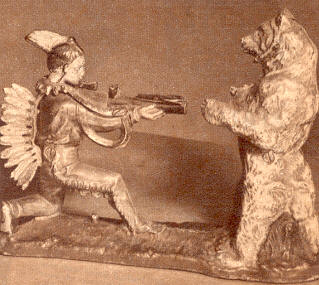
Many of
the old mechanical banks have been counterfeited recently and
sold to collectors as genuine. Prices for the banks vary from city to
city.
This is an original.
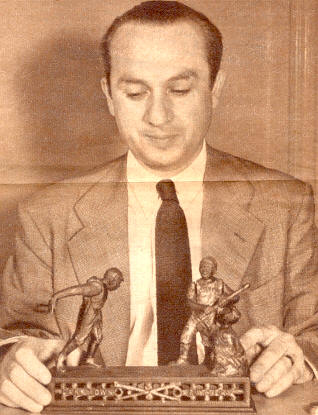
Milton
Stark shows how the pitcher tosses a nickel in this
three-man baseball bank. All three players move.
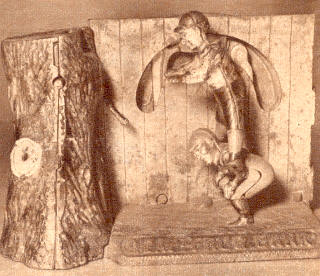
Although
mechanical banks, such as this leap-frog bank,
are most popular, collectors also value banks, with no
movable parts, that are replicas of famous buildings.





